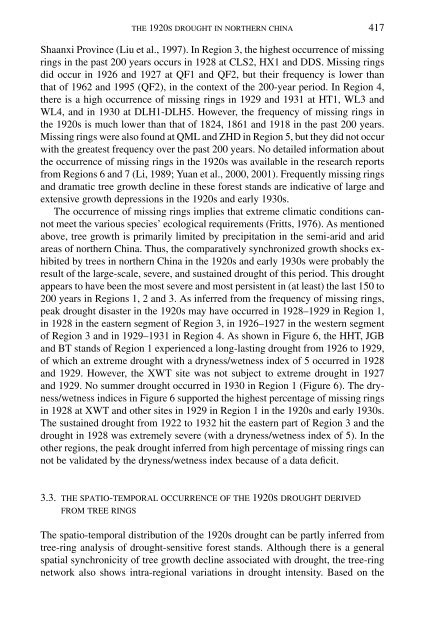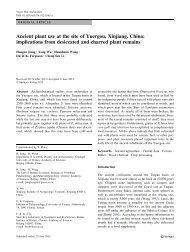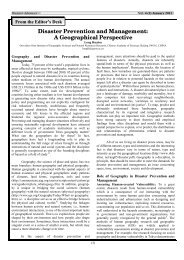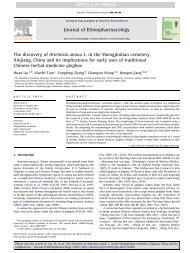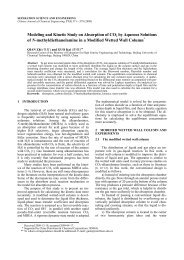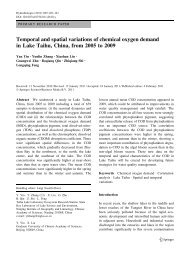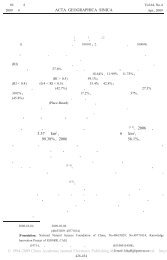THE 1920S DROUGHT RECORDED BY TREE RINGS AND ...
THE 1920S DROUGHT RECORDED BY TREE RINGS AND ...
THE 1920S DROUGHT RECORDED BY TREE RINGS AND ...
You also want an ePaper? Increase the reach of your titles
YUMPU automatically turns print PDFs into web optimized ePapers that Google loves.
<strong>THE</strong> <strong>1920S</strong> <strong>DROUGHT</strong> IN NOR<strong>THE</strong>RN CHINA 417Shaanxi Province (Liu et al., 1997). In Region 3, the highest occurrence of missingrings in the past 200 years occurs in 1928 at CLS2, HX1 and DDS. Missing ringsdid occur in 1926 and 1927 at QF1 and QF2, but their frequency is lower thanthat of 1962 and 1995 (QF2), in the context of the 200-year period. In Region 4,there is a high occurrence of missing rings in 1929 and 1931 at HT1, WL3 andWL4, and in 1930 at DLH1-DLH5. However, the frequency of missing rings inthe 1920s is much lower than that of 1824, 1861 and 1918 in the past 200 years.Missing rings were also found at QML and ZHD in Region 5, but they did not occurwith the greatest frequency over the past 200 years. No detailed information aboutthe occurrence of missing rings in the 1920s was available in the research reportsfrom Regions 6 and 7 (Li, 1989; Yuan et al., 2000, 2001). Frequently missing ringsand dramatic tree growth decline in these forest stands are indicative of large andextensive growth depressions in the 1920s and early 1930s.The occurrence of missing rings implies that extreme climatic conditions cannotmeet the various species’ ecological requirements (Fritts, 1976). As mentionedabove, tree growth is primarily limited by precipitation in the semi-arid and aridareas of northern China. Thus, the comparatively synchronized growth shocks exhibitedby trees in northern China in the 1920s and early 1930s were probably theresult of the large-scale, severe, and sustained drought of this period. This droughtappears to have been the most severe and most persistent in (at least) the last 150 to200 years in Regions 1, 2 and 3. As inferred from the frequency of missing rings,peak drought disaster in the 1920s may have occurred in 1928–1929 in Region 1,in 1928 in the eastern segment of Region 3, in 1926–1927 in the western segmentof Region 3 and in 1929–1931 in Region 4. As shown in Figure 6, the HHT, JGBand BT stands of Region 1 experienced a long-lasting drought from 1926 to 1929,of which an extreme drought with a dryness/wetness index of 5 occurred in 1928and 1929. However, the XWT site was not subject to extreme drought in 1927and 1929. No summer drought occurred in 1930 in Region 1 (Figure 6). The dryness/wetnessindices in Figure 6 supported the highest percentage of missing ringsin 1928 at XWT and other sites in 1929 in Region 1 in the 1920s and early 1930s.The sustained drought from 1922 to 1932 hit the eastern part of Region 3 and thedrought in 1928 was extremely severe (with a dryness/wetness index of 5). In theother regions, the peak drought inferred from high percentage of missing rings cannot be validated by the dryness/wetness index because of a data deficit.3.3. <strong>THE</strong> SPATIO-TEMPORAL OCCURRENCE OF <strong>THE</strong> <strong>1920S</strong> <strong>DROUGHT</strong> DERIVEDFROM <strong>TREE</strong> <strong>RINGS</strong>The spatio-temporal distribution of the 1920s drought can be partly inferred fromtree-ring analysis of drought-sensitive forest stands. Although there is a generalspatial synchronicity of tree growth decline associated with drought, the tree-ringnetwork also shows intra-regional variations in drought intensity. Based on the


